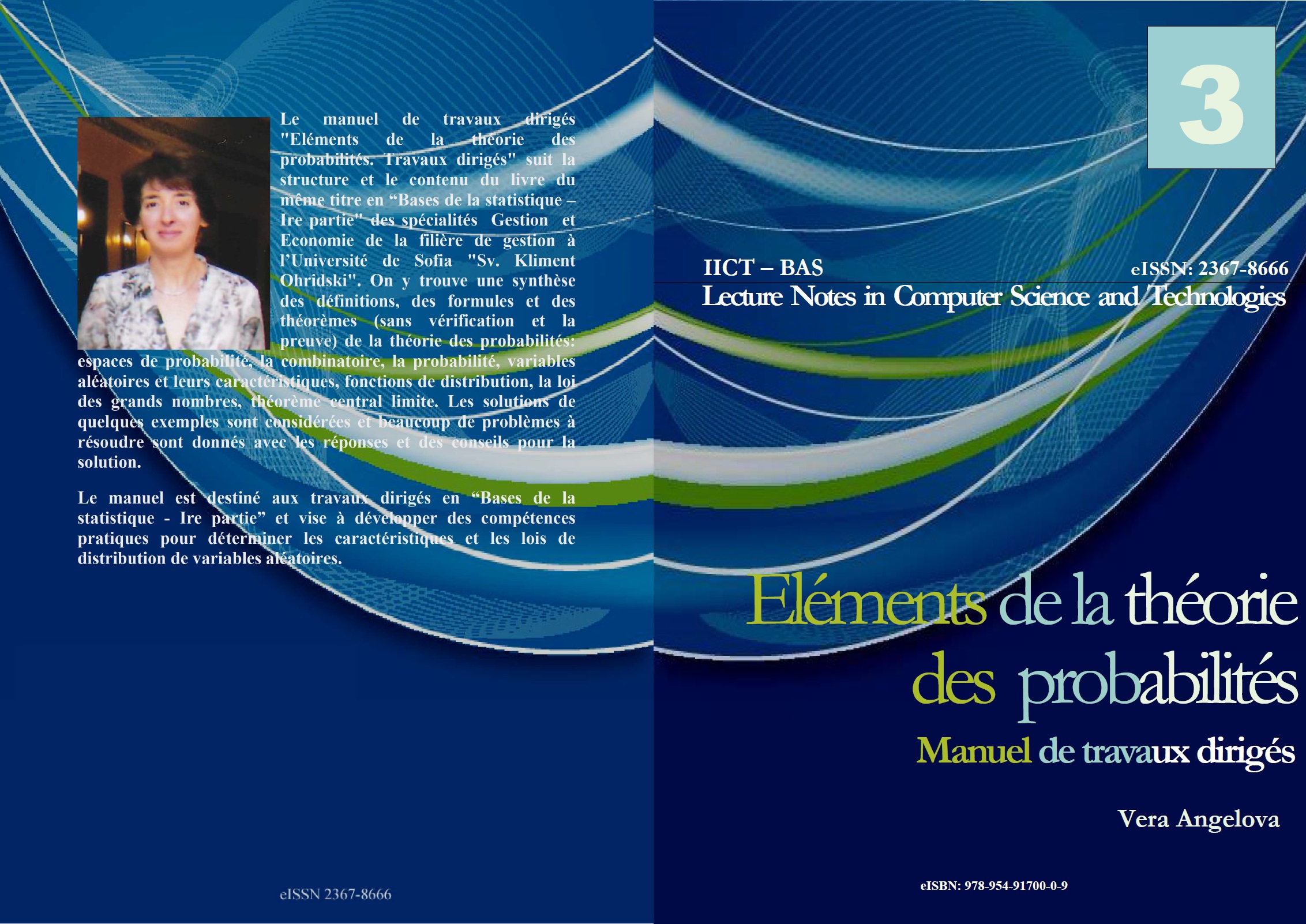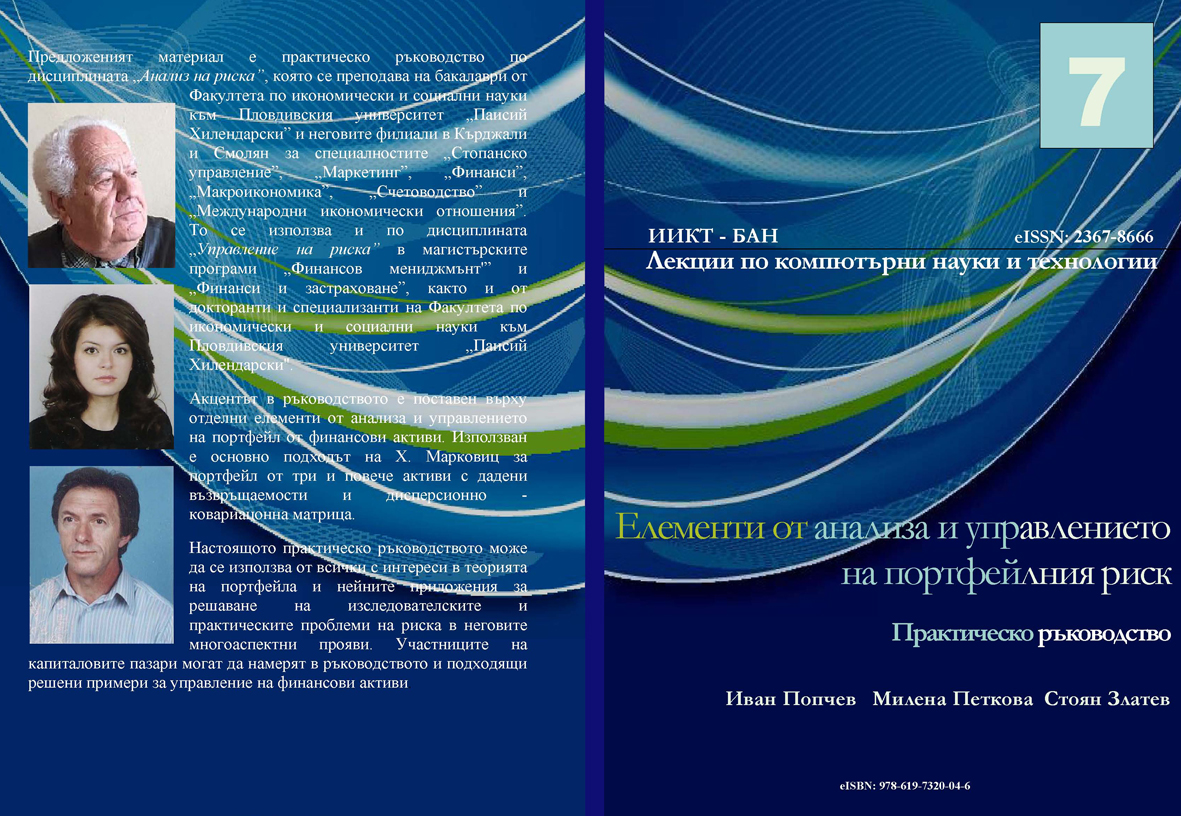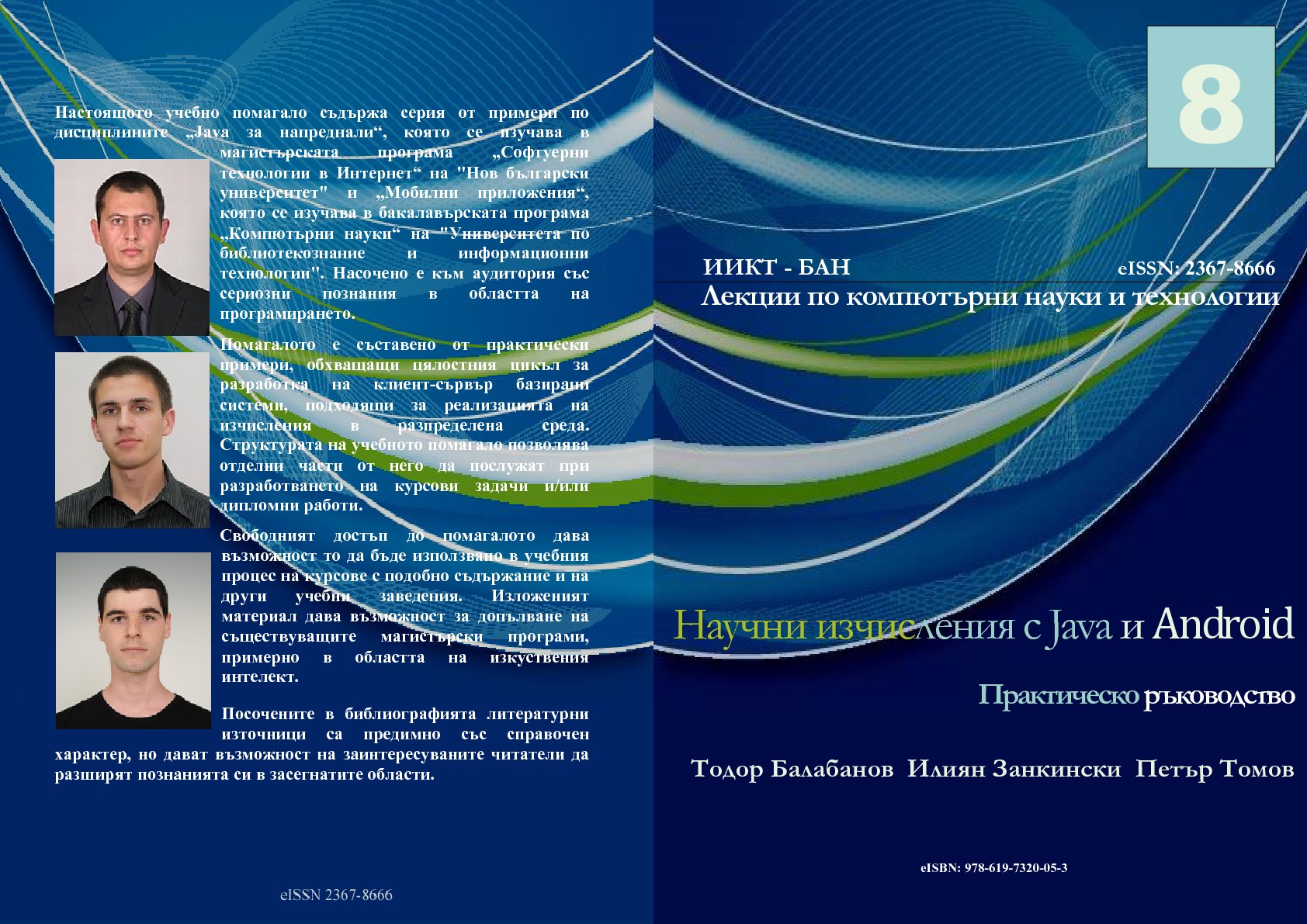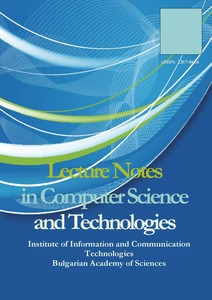2016
1/2016:
Ivan Popchev. Six topics of risk management. Lecture Notes in Computer Science and Technologies, No.1, IICT-BAS, 2016, eISSN: 2367-8666, eISBN: 978-954-91700-8-5, pp.73.


 The textbook includes basic topics on the discipline "Risk Management" in several graduate programs: Mathematical Models in Economics (University "Sv. Kliment Ohridski"), Business Administration (New Bulgarian University), Finance (New Bulgarian University), Financial Management (PU " Paisiy Hilendarski") and Business Information Technology (Burgas Free University).
The textbook includes basic topics on the discipline "Risk Management" in several graduate programs: Mathematical Models in Economics (University "Sv. Kliment Ohridski"), Business Administration (New Bulgarian University), Finance (New Bulgarian University), Financial Management (PU " Paisiy Hilendarski") and Business Information Technology (Burgas Free University).The textbook is built using theoretical results, solved numerical examples, charts and graphs. Such structure of the textbook allows individual topics and numerical examples to create interest in doctoral students and other teachers and students of masters and undergraduate programs in Bulgarian universities.
Free access to this textbook attracts the attention of practitioners because of the growing interest in risk management.
Bibliographical sources in Bulgarian and English give the textbook reference character.
2/2016:
Vera Angelova. Eléments de la théorie des probabilités. Lecture Notes in Computer Science and Technologies, No.2, IICT-BAS, 2016, eISSN: 2367-8666, eISBN: 978-954-91700-9-2, pp.220.


 Ce manuel est composé d’après le programme en « Bases de la statistique – I partie » des spécialités Gestion et Economie de la filière de gestion à l’Université de Sofia « Sv. Kliment Ohridski ». Le manuel encadre des notions de base et des thèmes de la théorie des probabilités : ensembles probabilistes, combinatoire, probabilité, variables aléatoires et leurs caractéristiques, fonctions de répartition et de distribution, paramètres, loi des grands nombres, théorème central limite.
Ce manuel est composé d’après le programme en « Bases de la statistique – I partie » des spécialités Gestion et Economie de la filière de gestion à l’Université de Sofia « Sv. Kliment Ohridski ». Le manuel encadre des notions de base et des thèmes de la théorie des probabilités : ensembles probabilistes, combinatoire, probabilité, variables aléatoires et leurs caractéristiques, fonctions de répartition et de distribution, paramètres, loi des grands nombres, théorème central limite.L'objectif de ce manuel est d'enrichir les savoirs en mathématique avec la théorie des probabilités, indispensable pour l'apprentissage des méthodes des théories économiques contemporaines et en fin de compte la statistique appliquée, des étudiants. De réaliser des connaissances théoriques et des utiles pratiques pour déterminer des caractéristiques et les lois de distribution des variables aléatoires.
3/2016:
Vera Angelova. Eléments de la théorie des probabilités. Travaux dirigés. Lecture Notes in Computer Science and Technologies, No.3, IICT-BAS, 2016, eISSN: 2367-8666, eISBN: 978-954-91700-0-9, pp.100.


 Le manuel de travaux dirigés "Eléments de la théorie des probabilités. Travaux dirigés " suit la structure et le contenu du livre du même titre en « Bases de la statistique – Ire partie » des spécialités Gestion et Economie de la filière de gestion à l’Université de Sofia « Sv. Kliment Ohridski ». On y trouve une synthèse des définitions, des formules et des théorèmes (sans vérification et la preuve) de la théorie des probabilités: espaces de probabilité, la combinatoire, la probabilité, variables aléatoires et leurs caractéristiques, fonctions de distribution, la loi des grands nombres, théorème central limite. Les solutions de quelques exemples sont considérées et beaucoup de problèmes à résoudre sont donnés avec les réponses et des conseils pour la solution.
Le manuel de travaux dirigés "Eléments de la théorie des probabilités. Travaux dirigés " suit la structure et le contenu du livre du même titre en « Bases de la statistique – Ire partie » des spécialités Gestion et Economie de la filière de gestion à l’Université de Sofia « Sv. Kliment Ohridski ». On y trouve une synthèse des définitions, des formules et des théorèmes (sans vérification et la preuve) de la théorie des probabilités: espaces de probabilité, la combinatoire, la probabilité, variables aléatoires et leurs caractéristiques, fonctions de distribution, la loi des grands nombres, théorème central limite. Les solutions de quelques exemples sont considérées et beaucoup de problèmes à résoudre sont donnés avec les réponses et des conseils pour la solution.Le manuel est destiné aux travaux dirigés en « Bases de la statistique - Ire partie » et vise à développer des compétences pratiques pour déterminer les caractéristiques et les lois de distribution de variables aléatoires.
4/2016:
Vera Angelova. Statistique descriptive. Lecture Notes in Computer Science and Technologies, No.4, IICT-BAS, 2016, eISSN: 2367-8666, eISBN: 978-619-7320-01-5, pp.207.


 Le manuel "Statistique descriptive" offre le matériel théorique et pratique, nécessaire à apprendre d’après le programme en “Bases de la statistique – IIe partie» des spécialités Gestion et Economie de la filière de gestion à l’Université de Sofia « Sv. Kliment Ohridski ». On y donne des notions de base, liées à la statistique descriptive. Les thèmes considérés sont : Série statistique uni- et bivariées, Paramètres de position, de dispersion, de forme et de concentration, Indice de Gini, Tableau de contingence, Corrélation linéaire, Ajustement linéaire ; Séries chronologiques, Prévision, Moyennes mobiles ; Echantillonnage, Distribution de la moyenne, de la dispersion et de la fréquence échantillonnalles.
Le manuel "Statistique descriptive" offre le matériel théorique et pratique, nécessaire à apprendre d’après le programme en “Bases de la statistique – IIe partie» des spécialités Gestion et Economie de la filière de gestion à l’Université de Sofia « Sv. Kliment Ohridski ». On y donne des notions de base, liées à la statistique descriptive. Les thèmes considérés sont : Série statistique uni- et bivariées, Paramètres de position, de dispersion, de forme et de concentration, Indice de Gini, Tableau de contingence, Corrélation linéaire, Ajustement linéaire ; Séries chronologiques, Prévision, Moyennes mobiles ; Echantillonnage, Distribution de la moyenne, de la dispersion et de la fréquence échantillonnalles.Le manuel a pour but de donner des connaissances théoriques et de développer des compétences pratiques pour le travail avec la terminologie et les méthodes de base de la statistique contemporaine comme un utile de planification, analyse, représentation et interprétation d’études expérimentales et non expérimentales.
5/2016:
Vera Angelova. Statistique inférentielle. Lecture Notes in Computer Science and Technologies, No.5, IICT-BAS, 2016, eISSN: 2367-8666, eISBN: 978-619-7320-00-8, pp.119.


 Le manuel "Statistique inférentielle" fait connaissance aux notions et les méthodes, lies a la quatrième phase de la méthode statistique l’Interprétation. Le manuel offre le matériel théorique et pratique, nécessaire à apprendre d’après le programme en “Statistique appliquée» des spécialités Gestion et Economie de la filière de gestion à l’Université de Sofia « Sv. Kliment Ohridski ». On y considère les notions de base et les deux groupes de méthodes de l’Interprétation - l'estimation des paramètres de la population et des tests d'hypothèses. Après un court rappel du thème de la statistique descriptive - Echantillonnage, Distribution de la moyenne, de la dispersion et de la fréquence échantillonnalles, on présente les thèmes d’Estimation – estimation ponctuelles e t intervalles et de Tests d’hypothèses – test paramétriques et non-paramétriques.
Le manuel "Statistique inférentielle" fait connaissance aux notions et les méthodes, lies a la quatrième phase de la méthode statistique l’Interprétation. Le manuel offre le matériel théorique et pratique, nécessaire à apprendre d’après le programme en “Statistique appliquée» des spécialités Gestion et Economie de la filière de gestion à l’Université de Sofia « Sv. Kliment Ohridski ». On y considère les notions de base et les deux groupes de méthodes de l’Interprétation - l'estimation des paramètres de la population et des tests d'hypothèses. Après un court rappel du thème de la statistique descriptive - Echantillonnage, Distribution de la moyenne, de la dispersion et de la fréquence échantillonnalles, on présente les thèmes d’Estimation – estimation ponctuelles e t intervalles et de Tests d’hypothèses – test paramétriques et non-paramétriques.Le manuel a pour but de donner des connaissances théoriques et de développer des compétences pratiques pour le choix de modèles convenables pour tester d’hypothèses et prendre de décisions.
6/2016:
Todor Balabanov. Programming in Android. Practical guide. Lecture Notes in Computer Science and Technologies, No.6, IICT-BAS, 2016, eISSN: 2367-8666, eISBN: 978-619-7320-02-2, pp.83.


 The textbook contains basic examples presented in the course "Introduction to electronic games design",
which is a part of the bachelor program "Computer Science" of the University of Library Studies and Information Technologies.
The textbook contains basic examples presented in the course "Introduction to electronic games design",
which is a part of the bachelor program "Computer Science" of the University of Library Studies and Information Technologies. The textbook is based on practical examples covering the entire cycle of electronic games production – idea, requirements analysis, design, development, testing and deployment. The selected structure of the textbook allows using its different parts in the semester assignments or final theses implementation.
Free access to these materials generates a growing interest for introduction of this discipline in the curricula of other Bulgarian universities as well as for the formation of a comprehensive master's program aimed at software production of entertainment multimedia products.
The textbook bibliography provides a good basis for a significant expansion of knowledge and skills in the field.
7/2017:
Ivan Popchev, Milena Petkova, Stoyan Zlatev.Elements of analysis and management of portfolio risk. Practical guide.
Lecture Notes in Computer Science and Technologies, No.7, IICT-BAS, 2017, eISSN: 2367-8666, eISBN: 978-619-7320-04-6, pp.30.


 This textbook is a part of the discipline “Risk Analysis”
and is used for teaching students of undergraduate programs
“Business Management”, “Marketing”, “Finance”, “Macroeconomics”, “Accounting”
and “International Economic Relations” of the Faculty of Economics and Social
Sciences at the University of Plovdiv “Paisii Hilendarski” and its branches
in Kardzhali and Smolyan. It is also used in the course “Risk Management” of
Master programs “Financial Management” and “Finance and Insurance”,
as well as for teaching post-graduate students of the Faculty of Economics
and Social Sciences at the Plovdiv University “Paisii Hilendarski”.
This textbook is a part of the discipline “Risk Analysis”
and is used for teaching students of undergraduate programs
“Business Management”, “Marketing”, “Finance”, “Macroeconomics”, “Accounting”
and “International Economic Relations” of the Faculty of Economics and Social
Sciences at the University of Plovdiv “Paisii Hilendarski” and its branches
in Kardzhali and Smolyan. It is also used in the course “Risk Management” of
Master programs “Financial Management” and “Finance and Insurance”,
as well as for teaching post-graduate students of the Faculty of Economics
and Social Sciences at the Plovdiv University “Paisii Hilendarski”.The accent is on elements of the analysis and control of a financial assets portfolio. For this purpose the authors apply the approach of H. Markowitz to a portfolio of three or more assets with given returns and variance - covariance matrix.
All readers interested in the theory of portfolio and its applications can use this textbook for solving various research and practical problems related to risk in its multifaceted manifestations. The capital market participants can also find in the textbook several useful examples for managing financial assets.
8/2018:
Todor Balabanov, Iliyan Zankinski, Petar Tomov.Scientific Computations with Java and Android. Practical guide.
Lecture Notes in Computer Science and Technologies, No.8, IICT-BAS, 2018, eISSN: 2367-8666, eISBN: 978-619-7320-05-3, pp.216.


 This handbook contains a set of examples on the Advanced Java course,
part of the master program "Internet Software Technologies"
in New Bulgarian University and Mobile Applications,
part of the bachelor program "Computer Science" in the University of
Library Studies and Information Technologies.
It targets an audience with a strong knowledge in the field of the computer programming.
This handbook contains a set of examples on the Advanced Java course,
part of the master program "Internet Software Technologies"
in New Bulgarian University and Mobile Applications,
part of the bachelor program "Computer Science" in the University of
Library Studies and Information Technologies.
It targets an audience with a strong knowledge in the field of the computer programming.The handbook is made up of practical examples covering the entire development cycle of client-server based systems suitable for the implementation of distributed computing solutions. The structure of the handbook is selected in such way that parts of it can be used to develop course assignments and/or diploma theses.
Free access to the handbook enables it to be taken up in other courses present in the curricula of other educational institutions. The presented material allows the extension of the existing master programs, for example in the field of artificial intelligence.
The information sources used are mostly of a reference nature but allow interested readers to expand their knowledge in the areas concerned.
9/2019:
Stanislav Harizanov, Raytcho Lazarov, Svetozar Margenov, Pencho Marinov.
The Best Uniform Rational Approximation:
Applications to Solving Equations Involving Fractional powers of Elliptic Operators.
Practical guide.
Lecture Notes in Computer Science and Technologies, No.9, IICT-BAS, 2019, eISSN: 2367-8666, eISBN:978-619-7320-08-4, pp. 85.


 The handbook is intended to be used as a complementary part of the courses on
“Numerical Methods for Sparse Linear Systems”
and “Convex Analysis and its Applications to Image Processing”
that are currently taught within the Master's program
“Computational Mathematics and Mathematical Modelling” in Sofia University "St. Kliment Ohridski".
The presented material can also serve as a short course on numerical methods for solving
fractional diffusion problems and as an extension of existing master or PhD programs in the
field of advanced scientific computations. The handbook considers the mathematical problem
of solving systems equations involving fractional powers of self-adjoint elliptic operators.
Due to the mathematical modelling of various non-local phenomena using such operators,
a number of numerical solution methods have been introduced, studied, and tested in the last two decades.
The handbook deals with the discrete counterpart of such problems obtained from finite difference or
finite element approximations of the corresponding elliptic problems. All necessary information
regarding the recently introduced by the authors' method based on best uniform rational approximation
(BURA) of a proper scalar function in the unit interval is provided. A substantial part of the handbook
is the presented 160 tables containing the related coefficients, zeros, poles, extreme points of the error function,
the terms of the BURA partial fraction decomposition, etc.
Links to website where one can download the files with the data characterizing the particular rational approximations,
which are available with enough significant digits, are also provided so one can use them in his/her own computations.
The examples are presented in a form ready for computer exercises.
The handbook is intended to be used as a complementary part of the courses on
“Numerical Methods for Sparse Linear Systems”
and “Convex Analysis and its Applications to Image Processing”
that are currently taught within the Master's program
“Computational Mathematics and Mathematical Modelling” in Sofia University "St. Kliment Ohridski".
The presented material can also serve as a short course on numerical methods for solving
fractional diffusion problems and as an extension of existing master or PhD programs in the
field of advanced scientific computations. The handbook considers the mathematical problem
of solving systems equations involving fractional powers of self-adjoint elliptic operators.
Due to the mathematical modelling of various non-local phenomena using such operators,
a number of numerical solution methods have been introduced, studied, and tested in the last two decades.
The handbook deals with the discrete counterpart of such problems obtained from finite difference or
finite element approximations of the corresponding elliptic problems. All necessary information
regarding the recently introduced by the authors' method based on best uniform rational approximation
(BURA) of a proper scalar function in the unit interval is provided. A substantial part of the handbook
is the presented 160 tables containing the related coefficients, zeros, poles, extreme points of the error function,
the terms of the BURA partial fraction decomposition, etc.
Links to website where one can download the files with the data characterizing the particular rational approximations,
which are available with enough significant digits, are also provided so one can use them in his/her own computations.
The examples are presented in a form ready for computer exercises.
Last update: June 2018


